Meteor scatter or meteor burst communications
Understand meteor scatter radio propagation and how it can be used at VHF and above to provide communications over longer distance communications than normally possible by other means.
Home » Antennas & Propagation » this page
Meteor scatter tutorial includes:
Meteor burst communications
Meteor types & showers
Meteor trails & radio signals
Propagation & frequencies
Meteor scatter or meteor burst communications use a form of radio communications system that is dependent on radio signals being scattered or reflected by meteor trails.
Meteor scatter communications is a specialized form of propagation that can be successfully used for radio communications over paths that extend up to 1500 or 2000 km.
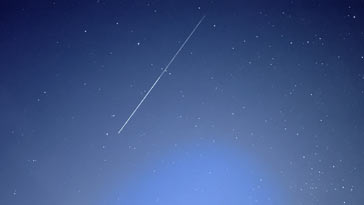
Meteor scatter or meteor burst communication provides form of radio propagation that can be used when no other form of radio propagation may be available.
While data has to be transmitted in bursts and there may be delays, it provides a very useful form of non-real-time communications that can be used in many circumstances.
Meteor burst / communication basics
Meteor scatter or meteor burst radio communications relies on the fact that meteors continually enter the Earth's atmosphere. As they do so they burn up leaving a trail of ionisation behind them. These trails which typically occur at altitudes between about 85 and 120 km can be used to "reflect" radio signals. In view of the fact that the ionisation trails left by the meteors are small, only minute amounts of the signal are reflected and this means that high powers coupled with sensitive receivers are often necessary.
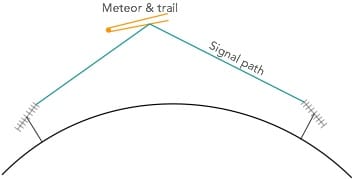
Meteor scatter propagation uses the fact that vast numbers of meteors enter the Earth's atmosphere. It is estimated that around 10^12 meteors enter the atmosphere each day and these have a total weight of around 10^6 grams.
Fortunately for everyone living below, the vast majority of these meteors are small, and are typically only the size of a grain of sand. It is found that the number of meteors entering the atmosphere is inversely proportional to their size. For a tenfold reduction in size, there is a tenfold increase in the number entering the atmosphere over a given period of time. From this it can be seen that very few large ones enter the atmosphere. Although most are burnt up in the upper atmosphere, there are a very few that are sufficiently large to survive entering the atmosphere and reach the earth.
Meteor burst communication applications
Meteor scatter or meteor burst communications are used for a number of applications on frequencies normally between about 40 and 150 MHz.
They are used professionally for a number of data transfer applications, particularly when transferring data from remote unmanned sites to a base using a radio communications link. Nowadays using computer controlled systems, this form of radio communications can offer an effective alternative to other means, and especially where satellites may need to be used because of the cost.
In other applications, radio hams use meteor scatter as a form of long distance VHF radio signal propagation.
Meteor burst communications system
The trails of ionisation left by meteors are short lived, and therefore the communications used needs to be able to be able to detect when a path exists and send high speed data while the radio path exists between the transmitter and the receiver.
A typical meteor scatter communications system, or meteor burst communications system will operate in a number of stages. A transmitter or master station will send out a probe signal. This is typically coded to ensure that communications are secure and not corrupted
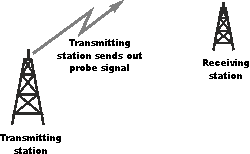
A meteor trail will appear at some point that enables the transmitted probe signal to be reflected back so that it is received by the remote station. When this occurs the remote station will decode the signal and it will in turn transmit back a coded signal to the master. This signal is in turn checked by the master.
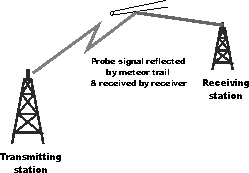
Once the link has been verified, data can be exchanged in either or both directions. Data is transmitted at high speed and also with constant error checks as the link will only be able to support communications for a few tenths of a second. After this point the diffusion of the meteor trail will reduce the ion density to a point where it will not reflect the signal back and the link will be lost.
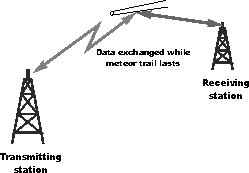
When the link is lost, the master station starts to transmit its coded probe signal searching for the next meteor trail that will be able to support communications.

Although the normal maximum range is around 1500 km, for extended ranges a relay system can be implemented. Here a station approximately half way between the two end points can operate in a store and forward mode, storing the received data and forwarding it on as the trails become available. Time taken for data to be sent across the overall link will obviously increase, but for most systems that would consider meteor burst communications, this should not be a problem.
Radio hams & meteor scatter
Radio hams also make widespread use of meteor scatter as a mode of propagation. Often contacts will be pre-arranged at a specific time and frequency. Alternatively when meteor showers are predicted, special calling frequencies will be used. Normally high gain directive antenna are used to enable a sufficient signal to noise ratio.
Often high speed Morse code transmissions are used, or other data modes are now available.
The use of meteor scatter enables radio hams to make contacts on VHF bands when no other forms of communication / propagation may be available.
 Written by Ian Poole .
Written by Ian Poole .
Experienced electronics engineer and author.
More Antenna & Propagation Topics:
EM waves
Radio propagation
Ionospheric propagation
Ground wave
Meteor scatter
Tropospheric propagation
Antenna basics
Cubical quad
Dipole
Discone
Ferrite rod
Log periodic antenna
Parabolic reflector antenna
Phased array antennas
Vertical antennas
Yagi
Antenna grounding
Installation guidelines
TV antennas
Coax cable
Waveguide
VSWR
Antenna baluns
MIMO
Return to Antennas & Propagation menu . . .



